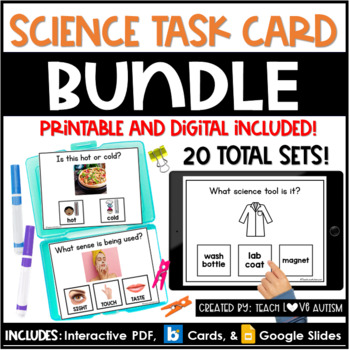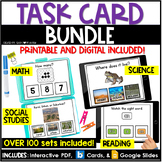Science Task Cards Bundle | Printable and Digital
- Zip
What educators are saying
Products in this Bundle (21)
showing 1-5 of 21 products
Bonus
Also included in
- Looking for resources to fill your centers or stations for the year covering all four core subjects? Trying to increase students' independence with reading, math, science, and social studies skills with printable and digital options? These printable and digital task cards work on many skills from grPrice $254.50Original Price $320.50Save $66.00
Description
Here are your science materials for the year! These task cards cover 20 science-related topics in both printable and digital forms! These can be best used as morning work, science center work, early finisher, independent workstation materials, and more! Use them to extend your science lessons and check for understanding after teaching.
Save 20% with this MEGA BUNDLE of Task Cards for Academic Skills! And have task cards to work for all main core subjects for the entire year!
Try a set out for FREE! Check out these Night and Day task cards!
The real photos on the task cards provide the students with a hands-on and engaging way to learn The digital version of this resource comes in three different ways to access depending on the platforms that you use.
20 sets in the bundle include:
- Five Senses
- Animal Classification and Groups
- Animal Habitats
- Animal or Plant?
- Hot and Cold?
- Domestic or Wild Animal?
- Habitats
- Human Body Parts
- Animal and Plant Life Cycles
- Living and Non-Living
- Magnetic or Non-Magnetic
- Natural or Manmade Resources
- Push or Pull?
- Recycling
- Science Tools
- Seasons
- Simple Machines
- Solar System
- Solid, Liquid, or Gas
- Weather Picture Match
DIGITAL VERSIONS INCLUDED:
- Interactive PDF with self-correction slides
- Boom Cards with audio, self-correction, and data collection
- Google Slides version with drag-and-drop answer selection
PRINTABLE VERSION INCLUDES:
- 24+ Printable Task Cards
Upload this activity to Google Classroom or another platform or learning management system of your choosing. The digital versions work on computers, smart boards, tablets, iPads, and smartphones.
Not sure how to use a digital interactive PDF? Download the instructions HERE.
Not sure how to print these materials? INSTRUCTIONS INCLUDED!
Have you subscribed to the Teach Love Autism Insider? It is a weekly email I send out providing you with the latest updates on my blog, website, and TPT store! I also give you tips, tricks, and hacks I've tested and tried to help you in your classroom! Lastly, you can gain access to the Free Resource Library!! To sign up to receive these emails CLICK HERE!
Follow me in many more ways to find out about new products and things happening in my classroom!
★ SATISFACTION:
Before purchasing this product, please read the product description and check out the preview to determine if the resource is appropriate for your students. If you have questions, do not hesitate to contact me:
✉ jenn@teachloveautism.com
How to get TPT credit to use on future purchases:
*Go to your My Purchases page. Beside each purchase, you'll see a Provide Feedback button. After selecting that button you will be taken to a page where you can give a rating and leave a comment for the product. I really appreciate your feedback as it helps me know what products are most helpful for your classroom!
Terms of Use:
Copyright © Teach Love Autism. All rights reserved by the author. This product is to be used by the individual downloading only. Copying for more than one teacher, classroom, department, school, or school system is prohibited. Failure to comply is a copyright infringement and a violation of the Digital Millennium Copyright Act (DMCA). Clipart and elements found in this PDF are copyrighted and cannot be extracted and used outside of this file without permission or license. Intended for classroom and personal use ONLY. See product file for clip-art and font credits.






